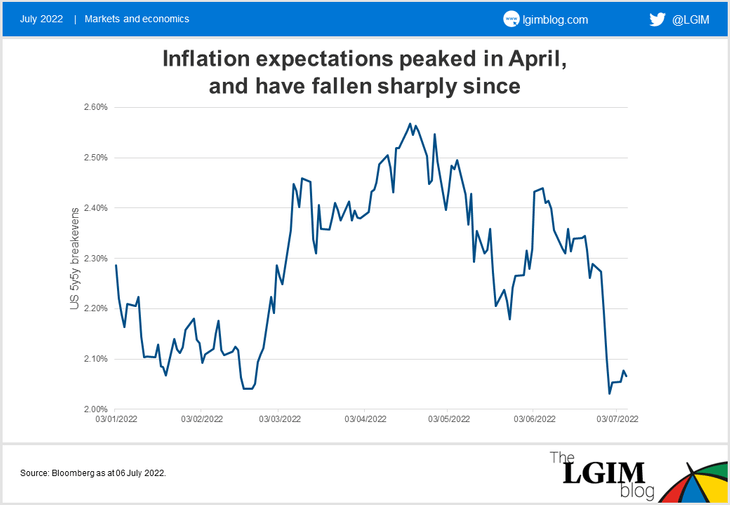18 Jul 2022
The past month saw a rapid shift in markets from worrying about inflation to worrying about growth. How should investors balance the risks?
In the first two weeks of June, all eyes were on inflation and concerns that the US Federal Reserve (Fed) and others would need to do more to rein it in. But since then, it’s all been about growth. Yields ended the month close to where they began, while risk assets were pummelled.
So, how do we balance those risks?
Based on inflation swaps and breakevens, medium-term global inflation expectations peaked in April and have fallen substantially since. Initially, that was accompanied by higher bond yields and reflected increasing confidence that central banks would do whatever it takes to smother the threat of wage-price inflation spirals.

More recently, though, we’ve seen inflation markets falling alongside lower bond yields, implying it’s no longer central bank rate hikes that are the driver, but rather the growing risk of economic recession. In many ways, and strange as it might sound, that’s a good thing; arguably the worst outcome would be a scenario where inflation expectations were so high that the Fed and others felt compelled to continue to act regardless of economic conditions.
Since April, our medium-term view has been negative on assets which are linked to US inflation, mainly due to our confidence that central banks will fight inflation, but also because it’s a position that we expected to help us if equity markets fell.
With US inflation breakevens now at their lowest since October 2021, our medium-term position no longer holds. We’re keen to lean against equity market weakness in a diversified way; if equity markets rise we’d expect that to be positive for inflation markets, too.
For now, we retain our high-conviction, medium-term negative view on UK inflation, but given the low level of five-year breakevens and our inflation forecast, we’re monitoring developments closely.
So, it’s away from the rock and towards the hard place. It’s very hard to get away from the deeply negative sentiment among investors, despite developed market unemployment being around its lowest in 50 years. Surveys show that investors are very bearish, which I all else were equal, we’d see as a positive for equities. Markets are telling a similar story on recession risks; yield curves are very volatile, but at the time of writing they imply about 0.9% of US rate cuts between the end of 2022 and the end of 2024.
We’re about to enter earnings season, which provides a wealth of bottom-up information. Like other investors, we expect earnings growth to slow from the first quarter of 2022. Equally, however, we see a low likelihood of a widespread slashing of forecasts and extensive profit warnings. With sentiment so beaten up, a lack of good news would likely be supportive for markets, in our view.
There is every chance that the US will have slipped into a technical recession in the second quarter, but the word ‘technical’ is important here. As our Head of Economics, Tim Drayson, has been highlighting, the first three months of the year were artificially affected by the timing impacts of disrupted supply chains; that led to artificially high fourth quarter growth in 2021, which then caused a record net trade deficit in early 2022. We still expect a rebound in the second quarter of 2022, but with ongoing disruptions there could be further timing effects that push it negative again. In the second half of the year, we expect US growth to increase marginally before a steep decline into a mild recession in the second half of 2023.
Of course, we have to be humble: forecasting the precise timing and depth of recessions is notoriously tricky. Nevertheless, we believe the US economic outlook does give us fundamental support for leaning against the current level of market weakness.
In the last couple of weeks, we’ve tactically favoured equities, and we’re gradually reducing our negative outlook on investment grade credit. We need to be careful though, with momentum so negative and such gloomy dual risks, there is every risk of further downside from here.
Disclaimer: Views in this blog do not promote, and are not directly connected to any Legal & General Investment Management (LGIM) product or service. Views are from a range of LGIM investment professionals and do not necessarily reflect the views of LGIM. For investment professionals only.